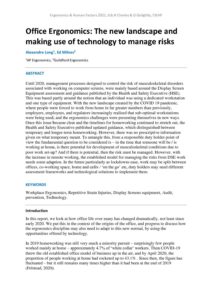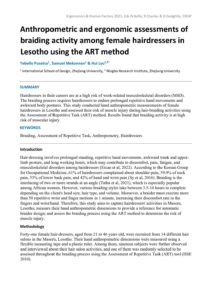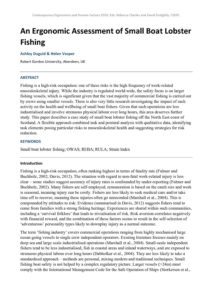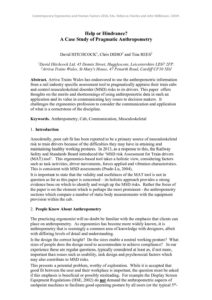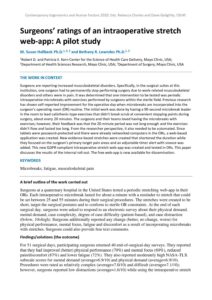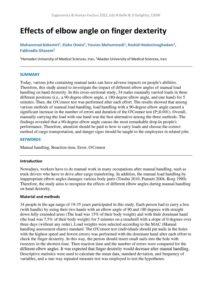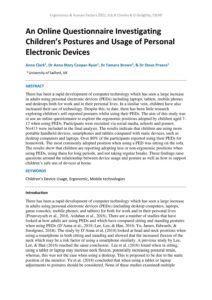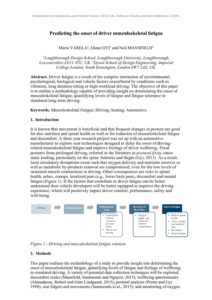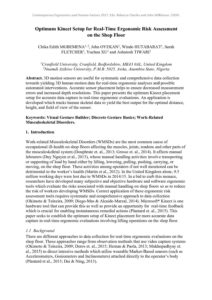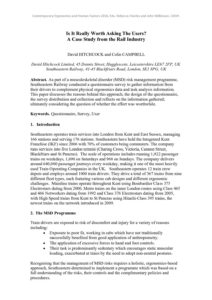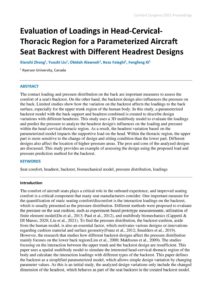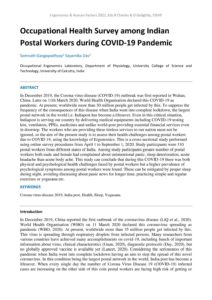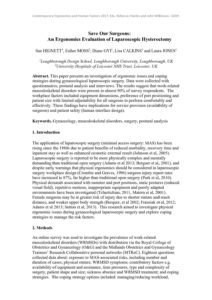Musculoskeletal
Office Ergonomics: The new landscape and making use of technology to manage risks
| Document | Author Alexandre Long, Ed Milnes |
| Abstract Until 2020, management processes designed to control the risk of musculoskeletal disorders associated with working on computer screens, were mainly based around the Display Screen Equipment assessment and guidance published by the Health and Safety Executive (HSE). This was based partly around the notion that an individual was using a dedicated workstation and one type of equipment. With the new landscape created by the COVID 19 pandemic, where people were forced to work from home in far greater numbers than previously, employers, employees, and regulators increasingly realised that sub-optimal workstations were being used, and the ergonomics challenges were presenting themselves in new ways. Once this issue became clear and the timelines for homeworking continued to stretch out, the Health and Safety Executive published updated guidance, which distinguished between temporary and longer-term homeworking. However, there was no prescriptive information given on what temporary meant. To untangle this, from a responsible duty holder point of view the fundamental question to be considered is – in the time that someone will be / is working at home, is there potential for development of musculoskeletal conditions due to poor work set-up? And if there is potential, then the risk must be managed. However, with the increase in remote working, the established model for managing the risks from DSE work needs some adaption. In the future particularly as lockdowns ease, work may be split between offices, co-working space, home and cafés / ‘on the go’ etc, duty holders may need different assessment frameworks and technological solutions to implement them. |
Anthropometric and ergonomic assessments of braiding activity among female hairdressers in Lesotho using the ART method
| Document | Author Tebello Pusetso, Samuel Mekonnen & Hui Lyu |
| Abstract Hairdressers in their careers are at a high risk of work-related musculoskeletal disorders (MSD). The braiding process requires hairdressers to endure prolonged repetitive hand movements and awkward body postures. This study conducted hand anthropometric measurements of female hairdressers in Lesotho and assessed their risk of muscle injury during hair-braiding activities using the Assessment of Repetitive Task (ART) method. Results found that braiding activity is at high risk of muscular injury. |
An Ergonomic Assessment of Small Boat Lobster Fishing
| Document | Author Ashley Duguid & Helen Vosper |
| Abstract Fishing is a high-risk occupation: one of these risks is the high frequency of work-related musculoskeletal injury. While the industry is regulated world-wide, the safety focus is on larger fishing vessels, which is significant given that the vast majority of commercial fishing is carried out by crews using smaller vessels. There is also very little research investigating the impact of such activity on the health and wellbeing of small boat fishers. Given that such operations are less industrialised and involve strenuous physical labour over long hours, this area deserves further study. This paper describes a case study of small boat lobster fishing off the North East coast of Scotland. A flexible approach combined task and postural analysis with qualitative data, identifying task elements posing particular risks to musculoskeletal health and suggesting strategies for risk reduction. |
Help or Hindrance? A Case Study of Pragmatic Anthropometry
| Document | Author David HITCHCOCK, Chris DIDIO and Tina REES |
| Abstract Arriva Trains Wales has endeavored to use the anthropometric information from a rail industry specific assessment tool to pragmatically appraise their train cabs and control musculoskeletal disorder (MSD) risks to its drivers. This paper offers thoughts on the merits and shortcomings of using anthropometric data in such an application and its value in communicating key issues to decision makers. It challenges the ergonomics profession to consider the communication and application of what is a cornerstone of the discipline. |
Surgeons’ ratings of an intraoperative stretch web-app: A pilot study
| Document | Author M. Susan Hallbeck Ph.D and Bethany R. Lowndes Ph.D |
| Abstract Surgeons are reporting increased musculoskeletal disorders. Specifically, in the surgical suites at this institution, one surgeon had to permanently stop performing surgery due to work-related musculoskeletal disorders and others were in pain. It was determined that one intervention to be tested was periodic intraoperative microbreaks with exercises performed by surgeons within the sterile field. Previous research has shown self-reported improvement for the operative day when microbreaks are incorporated into the surgeon’s operating room (OR) routine. The initial work was done by having a 90-second microbreak leader in the room to lead calisthenic-type exercises that didn’t break scrub at convenient stopping points during surgery, about every 20 minutes. The surgeons and their teams loved having the microbreaks with exercises; however, their feedback was that the 20-minute period was not long enough and the exercises didn’t flow and lasted too long. From the researcher perspective, it also needed to be automated. Since tablets were password-protected and there were already networked computers in the ORs, a web-based application was created. New evidence-based stretches were created that shortened the duration while they focused on the surgeon’s primary target pain areas and an adjustable timer alert with snooze was added. This new GDPR compliant intraoperative stretch web-app was created and tested in ORs. This paper discusses the results of the internal roll-out. The free web-app is now available for dissemination. |
Effects of elbow angle on finger dexterity
| Document | Author Mohammad Babamiri, Elahe Oveisi, Younes Mohammadi, Rashid Heidarimoghadam & Fakhradin Ghasem |
| Abstract Today, various jobs containing manual tasks can have adverse impacts on people's abilities. Therefore, this study aimed to investigate the impact of different elbow angles of manual load handling on hand dexterity. In this cross-sectional study, 34 males manually carried loads in three different positions (i.e., a 90-degree elbow angle, a 180-degree elbow angle, and one hand) for 5 minutes. Then, the O'Connor test was performed after each effort. The results showed that among various methods of manual load handling, load handling with a 90-degree elbow angle caused a significant increase in the number of errors and duration of the O'Connor test (P≤0.001). Overall, manually carrying the load with one hand was the best alternative among the three methods. The findings revealed that a 90-degree elbow angle causes the most remarkable drop in people's performance. Therefore, attention should be paid to how to carry loads and choose the correct method of cargo transportation, and danger signs should be taught to the employees in related jobs. |
An Online Questionnaire Investigating Children’s Postures and Usage of Personal Electronic Devices
| Document | Author Anna Clark, Dr Anna Mary Cooper-Ryan, Dr Tamara Brown, & Dr Steve Preece |
| Abstract There has been a rapid development of computer technology which has seen a large increase in adults using personal electronic devices (PEDs) including laptops, tablets, mobile phones and desktops both for work and in their personal lives. In a similar vein, children have also increased their use of technology. Despite this, to date, there has been little research exploring children's self-reported postures whilst using their PEDs. The aim of this study was to use an online questionnaire to explore the ergonomic positions adopted by children aged 7-17 when using PEDs. Participants were recruited via social media, schools and posters. N=413 were included in the final analysis. The results indicate that children are using more portable handheld devices, smartphones and tablets compared with static devices, such as desktop computers and laptops. Over 80% of the participants reported using their PEDs for homework. The most commonly adopted position when using a PED was sitting on the sofa. The results show that children are reporting adopting less or non-ergonomic positions when using PEDs, using them for long periods, and not taking regular breaks. These findings raise questions around the relationship between device usage and posture as well as how to support children’s safe use of devices at home. |
Predicting the onset of driver musculoskeletal fatigue
| Document | Author Maria VARELA, Diane GYI and Neil MANSFIELD |
| Abstract Driver fatigue is a result of the complex interaction of environmental, psychological, biological and vehicle factors exacerbated by conditions such as vibration, long duration sitting or high-workload driving. The objective of this paper is to outline a methodology capable of providing insight on determining the onset of musculoskeletal fatigue, quantifying levels of fatigue and fatigue tolerance in simulated long-term driving. |
An Online Manual Handling Toolkit to Improve Skills and Reduce Risks
| Document | Author Jo-anne WEBB, Deborah HARRISON, Katy SZCZEPURA |
| Abstract |
Optimum Kinect Setup for Real-Time Ergonomic Risk Assessment on the Shop Floor
| Document | Author Chika Edith MGBEMENA, John OYEKAN, Windo HUTABARAT, Sarah FLETCHER, Yuchun XU and Ashutosh TIWARI |
| Abstract 3D motion sensors are useful for systematic and comprehensive data collection towards yielding 3D human motion data for real-time ergonomic analyses and possible automated interventions. Accurate sensor placement helps to ensure decreased measurement errors and increased depth resolutions. This paper presents the optimum Kinect placement setup for accurate data capture in real-time ergonomic evaluations. An application is developed which tracks human skeletal data to yield the best output for the optimal distance, height, and field of view of the sensor. |
Is It Really Worth Asking The Users? A Case Study from the Rail Industry
| Document | Author David HITCHCOCK and Colin CAMPBELL |
| Abstract As part of a musculoskeletal disorder (MSD) risk management programme, Southeastern Railway conducted a questionnaire survey to gather information from their drivers to complement physical ergonomics data and task analysis information. This paper discusses the reasons behind this approach, the design of the questionnaire, the survey distribution and collection and reflects on the information gathered; ultimately considering the question of whether the effort was worthwhile. |
Evaluation of Loadings in Head-Cervical-Thoracic Region for a Parameterized Aircraft Seat Backrest with Different Headrest Designs
Occupational Health Survey among Indian Postal Workers during COVID-19 Pandemic
| Document | Author Somnath Gangopadhyay and Sayantika Das |
| Abstract In December 2019, the Corona-virus-disease (COVID-19) outbreak was first reported in Wuhan, China. Later on 11th March 2020, World Health Organisation declared this COVID-19 as pandemic. At present, worldwide more than 30 million people get infected by this. To suppress the frequency of the consequences of this disease when India went into complete lockdown, the largest postal network in the world i.e. Indiapost has become a lifesaver. Even in this critical situation, Indiapost is serving our country by delivering medical equipments including COVID-19 testing kits, ventilators, PPEs, medicines and unlike world-post providing essential financial services even in doorstep. The workers who are providing these tireless services to our nation must not be ignored, so the aim of the present study is to assess their health challenges among postal workers due to COVID 19, using the knowledge of Ergonomics. This is a cross-sectional study performed using online survey procedures from April 1 to September 1, 2020. Study participants were 310 postal workers from different states of India. Among study participants greater number of postal workers both male and female had complained about unintentional panic, sleep deterioration, acute headache than acute body ache. This study can conclude that during this COVID-19 there was both physical and psychological health challenges faced by postal workers but a higher prevalence of psychological symptoms among postal workers were found. These can be mitigated by proper sleep during night, avoiding discussing about panic news for longer time, practicing simple and regular exercises or yogasana etc. |
Save Our Surgeons: An Ergonomics Evaluation of Laparoscopic Hysterectomy
| Document | Author Sue HIGNETT, Esther MOSS, Diane GYI, Lisa CALKINS and Laura JONES |
| Abstract This paper presents an investigation of ergonomic issues and coping strategies during gynaecological laparoscopic surgery. Data were collected with questionnaires, postural analysis and interviews. The results suggest that work-related musculoskeletal disorders were present in almost 90% of survey respondents. The workplace factors included equipment dimensions, preference of port positioning and patient size with limited adjustability for all surgeons to perform comfortably and effectively. These findings have implications for service provision (availability of surgeons) and patient safety (human interface design). |

